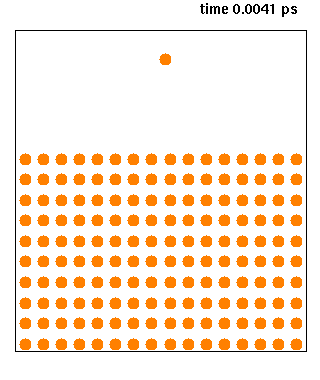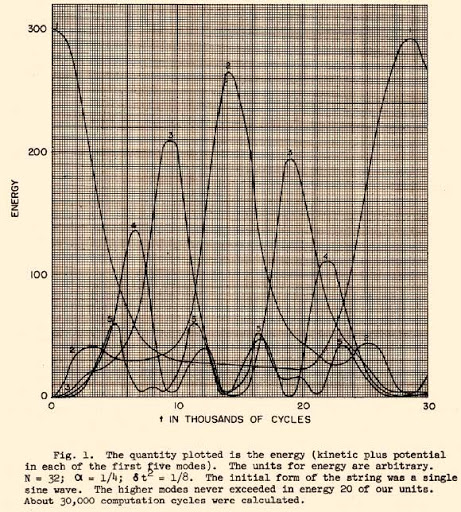|
Verlet List
A Verlet list (named after Loup Verlet) is a data structure in molecular dynamics simulations to efficiently maintain a list of all particles within a given cut-off distance of each other. This method may easily be applied to Monte Carlo simulations. For short-range interactions, a cut-off radius is typically used, beyond which particle interactions are considered "close enough" to zero to be safely ignored. For each particle, a Verlet list is constructed that lists all other particles within the potential cut-off distance, plus some extra distance so that the list may be used for several consecutive Monte Carlo "sweeps" (set of Monte Carlo steps or moves) before being updated. If we wish to use the same Verlet list n times before updating, then the cut-off distance for inclusion in the Verlet list should be R_c + 2nd, where R_c is the cut-off distance of the potential, and d is the maximum Monte Carlo step (move) of a single particle. Thus, we will spend of order N^2 time to compu ... [...More Info...] [...Related Items...] OR: [Wikipedia] [Google] [Baidu] |
Loup Verlet
Loup Verlet (; 24 May 1931 – 13 June 2019) was a French physicist who pioneered the computer simulation of molecular dynamics models. In a famous 1967 paper he used what is now known as Verlet integration (a method for the numerical integration of equations of motion) and the Verlet list (a data structure that keeps track of each molecule's immediate neighbors in order to speed computer calculations of molecule-to-molecule interactions). He received his PhD in 1957; his PhD work was initially conducted in the group of Victor Weisskopf at the Massachusetts Institute of Technology and concluded under the guidance of Maurice Lévy at the École normale supérieure in Paris. From 1957 to 1993 he worked mostly on the physics of the liquid state. He also wrote about the history of science. In his book "La Malle de Newton" (1993) he argued that Isaac Newton was an important transition figure between the medieval, mainly religious, world of ideas and the modern scientific way of analyz ... [...More Info...] [...Related Items...] OR: [Wikipedia] [Google] [Baidu] |
Molecular Dynamics
Molecular dynamics (MD) is a computer simulation method for analyzing the Motion (physics), physical movements of atoms and molecules. The atoms and molecules are allowed to interact for a fixed period of time, giving a view of the dynamics (mechanics), dynamic "evolution" of the system. In the most common version, the trajectory, trajectories of atoms and molecules are determined by Numerical integration, numerically solving Newton's laws of motion, Newton's equations of motion for a system of interacting particles, where Force (physics), forces between the particles and their potential energy, potential energies are often calculated using interatomic potentials or molecular mechanics, molecular mechanical Force field (chemistry), force fields. The method is applied mostly in chemical physics, materials science, and biophysics. Because molecular systems typically consist of a vast number of particles, it is impossible to determine the properties of such complex systems analyt ... [...More Info...] [...Related Items...] OR: [Wikipedia] [Google] [Baidu] |
Monte Carlo Simulation
Monte Carlo methods, or Monte Carlo experiments, are a broad class of computational algorithms that rely on repeated random sampling to obtain numerical results. The underlying concept is to use randomness to solve problems that might be deterministic in principle. The name comes from the Monte Carlo Casino in Monaco, where the primary developer of the method, mathematician Stanisław Ulam, was inspired by his uncle's gambling habits. Monte Carlo methods are mainly used in three distinct problem classes: optimization, numerical integration, and generating draws from a probability distribution. They can also be used to model phenomena with significant uncertainty in inputs, such as calculating the risk of a nuclear power plant failure. Monte Carlo methods are often implemented using computer simulations, and they can provide approximate solutions to problems that are otherwise intractable or too complex to analyze mathematically. Monte Carlo methods are widely used in various ... [...More Info...] [...Related Items...] OR: [Wikipedia] [Google] [Baidu] |
Cell Lists
Cell lists (also sometimes referred to as cell linked-lists) is a data structure in molecular dynamics simulations to find all atom pairs within a given cut-off distance of each other. These pairs are needed to compute the short-range non-bonded interactions in a system, such as Van der Waals force In molecular physics and chemistry, the van der Waals force (sometimes van der Waals' force) is a distance-dependent interaction between atoms or molecules. Unlike ionic or covalent bonds, these attractions do not result from a chemical elec ...s or the short-range part of the electrostatic interaction when using Ewald summation. Algorithm Cell lists work by subdividing the simulation domain into cells with an edge length greater than or equal to the cut-off radius of the interaction to be computed. The particles are sorted into these cells and the interactions are computed between particles in the same or neighbouring cells. In its most basic form, the non-bonded interactions f ... [...More Info...] [...Related Items...] OR: [Wikipedia] [Google] [Baidu] |
Verlet Integration
Verlet integration () is a numerical method used to integrate Newton's equations of motion. It is frequently used to calculate trajectories of particles in molecular dynamics simulations and computer graphics. The algorithm was first used in 1791 by Jean Baptiste Delambre and has been rediscovered many times since then, most recently by Loup Verlet in the 1960s for use in molecular dynamics. It was also used by P. H. Cowell and A. C. C. Crommelin in 1909 to compute the orbit of Halley's Comet, and by Carl Størmer in 1907 to study the trajectories of electrical particles in a magnetic field (hence it is also called Størmer's method). The Verlet integrator provides good numerical stability, as well as other properties that are important in physical systems such as time reversibility and preservation of the symplectic form on phase space, at no significant additional computational cost over the simple Euler method. Basic Størmer–Verlet For a second-order differential ... [...More Info...] [...Related Items...] OR: [Wikipedia] [Google] [Baidu] |
Fast Multipole Method
__NOTOC__ The fast multipole method (FMM) is a numerical technique that was developed to speed up the calculation of long-ranged forces in the ''n''-body problem. It does this by expanding the system Green's function using a multipole expansion, which allows one to group sources that lie close together and treat them as if they are a single source. The FMM has also been applied in accelerating the iterative solver in the method of moments (MOM) as applied to computational electromagnetics problems, and in particular in computational bioelectromagnetism. The FMM was first introduced in this manner by Leslie Greengard and Vladimir Rokhlin Jr. and is based on the multipole expansion of the vector Helmholtz equation. By treating the interactions between far-away basis functions using the FMM, the corresponding matrix elements do not need to be explicitly stored, resulting in a significant reduction in required memory. If the FMM is then applied in a hierarchical manner, it can ... [...More Info...] [...Related Items...] OR: [Wikipedia] [Google] [Baidu] |
Molecular Mechanics
Molecular mechanics uses classical mechanics to model molecular systems. The Born–Oppenheimer approximation is assumed valid and the potential energy of all systems is calculated as a function of the nuclear coordinates using Force field (chemistry), force fields. Molecular mechanics can be used to study molecule systems ranging in size and complexity from small to large biological systems or material assemblies with many thousands to millions of atoms. All-atomistic molecular mechanics methods have the following properties: * Each atom is simulated as one particle * Each particle is assigned a radius (typically the van der Waals radius), polarizability, and a constant net charge (generally derived from quantum calculations and/or experiment) * Bonded interactions are treated as ''springs'' with an equilibrium distance equal to the experimental or calculated bond length Variants on this theme are possible. For example, many simulations have historically used a ''united-atom'' ... [...More Info...] [...Related Items...] OR: [Wikipedia] [Google] [Baidu] |
List Of Software For Molecular Mechanics Modeling
This is a list of computer programs that are predominantly used for molecular mechanics calculations. See also * Car–Parrinello molecular dynamics * Comparison of force-field implementations * Comparison of nucleic acid simulation software * List of molecular graphics systems * List of protein structure prediction software * List of quantum chemistry and solid-state physics software * List of software for Monte Carlo molecular modeling * List of software for nanostructures modeling *Molecular design software *Molecular dynamics * Molecular modeling on GPUs *Molecule editor *PyMOL PyMOL is a source-available molecular visualization system created by Warren Lyford DeLano. It was commercialized initially by DeLano Scientific LLC, which was a private software company dedicated to creating useful tools that become universall ... Notes and references External linksSINCRIS [...More Info...] [...Related Items...] OR: [Wikipedia] [Google] [Baidu] |
University Of Helsinki
The University of Helsinki (, ; UH) is a public university in Helsinki, Finland. The university was founded in Turku in 1640 as the Royal Academy of Åbo under the Swedish Empire, and moved to Helsinki in 1828 under the sponsorship of Alexander I of Russia, Tsar Alexander I. The University of Helsinki is the oldest and largest university in Finland with a range of disciplines available. In 2022, around 31,000 students were enrolled in the degree programs of the university spread across 11 faculties and 11 research institutes. As of 1 August 2005, the university complies with the harmonized structure of the Europe-wide Bologna Process and offers bachelor, master, licenciate, and Doctorate, doctoral degrees. Admission to degree programmes is usually determined by entrance examinations, in the case of bachelor's degrees, and by prior degree results, in the case of master and postgraduate degrees. The university is bilingual, with teaching by law provided both in Finnish and Swedi ... [...More Info...] [...Related Items...] OR: [Wikipedia] [Google] [Baidu] |
Molecular Dynamics
Molecular dynamics (MD) is a computer simulation method for analyzing the Motion (physics), physical movements of atoms and molecules. The atoms and molecules are allowed to interact for a fixed period of time, giving a view of the dynamics (mechanics), dynamic "evolution" of the system. In the most common version, the trajectory, trajectories of atoms and molecules are determined by Numerical integration, numerically solving Newton's laws of motion, Newton's equations of motion for a system of interacting particles, where Force (physics), forces between the particles and their potential energy, potential energies are often calculated using interatomic potentials or molecular mechanics, molecular mechanical Force field (chemistry), force fields. The method is applied mostly in chemical physics, materials science, and biophysics. Because molecular systems typically consist of a vast number of particles, it is impossible to determine the properties of such complex systems analyt ... [...More Info...] [...Related Items...] OR: [Wikipedia] [Google] [Baidu] |



